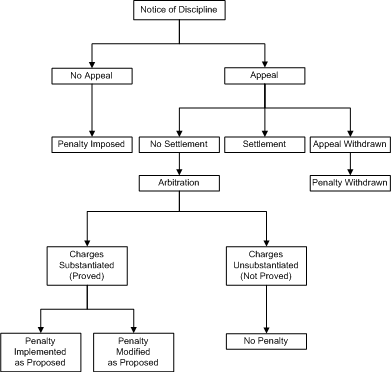A disciplinary procedure is directed against the worker’s behavior rather than the person. Key features of an effective process include the following principles of disciplining workers.
 1. The length of time between the misconduct and the discipline should be short. For discipline to be most effective, it must be administered as soon as possible, but without making an emotional, irrational decision.
1. The length of time between the misconduct and the discipline should be short. For discipline to be most effective, it must be administered as soon as possible, but without making an emotional, irrational decision.
2. Disciplinary action should be preceded by advance warning. Noting rule infractions in an employee’s record is not sufficient to support disciplinary action. An employee who is not advised of an infraction is not considered to have been given a warning. Noting that the employee was advised of the infraction and having the employee sign on discipline form are both valid employment practices. Failure to warn an employee of the consequences of repeated violations of a rule is a frequently cited reason for overturning a disciplinary action.
3. Consistency in the discipline procedure is key. Inconsistency lowers morale, diminishes respect for the supervisor, and leads to grievances. Consistency does not mean that an absence of past infractions, long length of service, a good work record, and other mitigating factors should not be considered when applying discipline. However, an employee should feel that under essentially the same circumstances any other employee would have received the same punishment/penalty.
4. Supervisors should take steps to ensure impartiality when applying discipline. The employee should feel that the disciplinary action is a consequence of behavior, not of personality or relationship to the supervisor. The supervisor should avoid arguing with the employee and should administer discipline in a straightforward, calm manner. Administering discipline without anger or apology and then resuming a pleasant relationship aid in reducing the negative effects of discipline.
5. Ordinarily, the supervisor should administer discipline in private. Only in the case of gross insubordination or flagrant and serious rule violations is a public reprimand desirable. Then a public reprimand helps the supervisor regain control of a situation. Even in such situations, however, the supervisor’s objective should be to regain control, not to embarrass the employee.
6. The supervisor should warn the employee of the result of repeated violations. Sometimes suggestions to the employee on ways to correct behavior are beneficial. Supervisors should be very reluctant to impose disciplinary suspensions and to discharge workers. Usually, discipline of this degree is reserved for higher levels of management. However, even though supervisors usually lack the power to administer disciplinary suspensions or to discharge workers, they are nearly always the ones who must recommend such action to higher management.
7. Finally, it is necessary to document the action taken and inform others in the organization. Any time an organization takes disciplinary action, it must consider the possibility of an Equal Employment Opportunity complaint. The documentation should be sufficiently detailed that another manager at a similar level in the organization would come to the same conclusions or least see clearly why the decision was made. Sufficient documentation does not mean that every detail of an individual’s work needs to be recorded. Rather, the manager should keep accurate records of those elements that significantly contribute to or hamper the work effort. In addition, this information, both positive and negative, should be communicated to the employee either orally or in writing.

 Follow
Follow